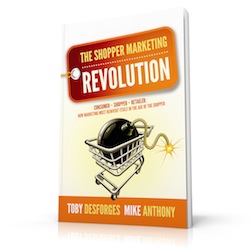A while ago I wrote what ended up being my most popular blog post yet, on the topic of creating shopper insights.
It raised lots of questions, lots of comments, but still much of the feedback  focused on how hard people felt it was to actually dig out an “insightâ€. I spend a lot of my life discovering insights for clients. So I’ve spent the last month or so observing how I work, and giving further thought to how I approach the task,  to add more to the original guidelines in my last post (If you missed that one, I suggest you go and read it here first!).
The difficulties of creating insight (or as Kenneth Chua of Tesco pointed out in a comment “finding†or “discovering insights†– as they cannot be created) – seems to be getting worse. As marketers we have more data than ever before, yet far from making it easier to create insights, it appears that this is making it harder. Large organizations are creating huge shopper marketing departments, geared up to crank through the data, check all the key KPIs, analyze and format the data as efficiently as possible. Unfortunately efficiency driven efforts, in my experience, rarely yield insights.
The dangers of “cranking the data through an analysis machine†are two-fold:
No-one takes the time to allow insights to develop
No-one soaks in the data anymore. Shopper marketers use data to measure performance (don’t get me wrong, I LOVE that we are starting to do that), but that is analysis, not insight. Data is used to measure against a broader set of KPIs than ever before, but that doesn’t necessarily create insight. Research companies use a template driven approach to present the data to clients, and if you’re lucky the data is analyzed as well as formatted. But the insight is missing. Or worse, the conclusions drawn are irrelevant, misguided, or just plain wrong (and are still not insightful).
 Are we relying on the data (or the latest data) too much?
Are we relying on the data (or the latest data) too much?
Too much data seems also to lead to myopia. We look too hard at one set of data and we can’t see the wood for the trees. Standing In the torrent of retail point of sale data, it’s easy to forget other reports, other knowledge and other inputs. The idea of the 5 W’s (Who, Where, When, What, Where) as a framework for understanding is well-known (though my favorite is the sixth W “Why-not?â€). As Maureen Colley pointed out in her brilliantly articulated comment, retail data tells us little of the “why†and it is the “why†question that so often delivers the insight. Why does the shopper do that? Understanding their behavior is great, but it is understanding what drives that behavior that is the key to changing it – that is where insight lies.
So what to do?
My last blog on insights  suggested  a number of simple techniques to improve the chances of finding an insight, but here are a number of additional “tricks†and techniques  that I habitually use which you might find useful when considering how to find shopper insights.
Never rely on one data source – Insight typically occurs when connections are made – the intuitive leap that identifies the unobvious. Staring at one source of data is likely to dull the brain, rather than feed it and challenge it
Don’t rely on data – I love data, don’t get me wrong. But stir in some other things. What do you think? What does qualitative research tell you? What else do you know about shoppers? What else do you think you know? Relying on gut alone is dangerous for sure: relying just on data may be less dangerous, but it’s not going to lead you to insight glory.
Ask “Whyâ€, and “Why Not†– Why people do things is really interesting to understand. Knowing why they don’t can be really powerful. The other “wâ€s are great, but Why is where most insight resides.
Ask the agency to give you a set of charts without the headlines. You might be lucky. You might have one of the few shopper research agencies who can genuinely create insight. But many struggle,  so let’s assume you don’t. Ignore their headlines. Better still get a set of charts without headlines. What does it say to you? If you read their headlines they will direct your thinking Even if you try to ignore their musings, it will have subconsciously led your thinking. Better to look at data clean (first).
Look at the data, not just the PowerPoint. I wish I didn’t have to say this but judging by the proportion of clients who do not have the data tables or raw data, I’m surmising that there are far too many marketers relying just on the charts the agency presents. Dig into the data yourself. Get colleagues to do the same. Even looking at the same picture, everybody sees something differently. The same is true for data.
Invert the answer. One of my favorite tricks (keep it to yourself!), – the “invert the answer†check. Take whatever conclusion the agency has drawn, and look at it upside-down. If they claim that 64% of smartphone users used their phone for shopping – think about the 36% who didn’t. Why ever not? If 82% of shoppers planned the category, what about the 18% who didn’t. It doesn’t always work, but quite often I find this starts me thinking about different shoppers, thinking differently, and that often leads to an “aha†that nobody else spots.
Searching for insights can be the most rewarding part of marketing. It can also be the most frustrating. Try some of these tips, and let me know what works for you (whether its one of these or something else you do). Have some fun with it!




